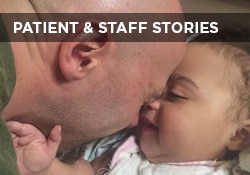This website uses cookies so that we can provide you with the best user experience possible. Cookie information is stored in your browser and performs functions such as recognising you when you return to our website and helping our team to understand which sections of the website you find most interesting and useful.

Susan E. Mazer, Ph.D. Blog
Thoughts and ideas on healthcare
Hi, and welcome to my blog! I'm Susan E. Mazer -- a knowledge expert and thought leader on how the environment of care impacts the patient experience. Topics I write about include safety, satisfaction, hospital noise, nursing, care at the bedside, and much more.
Is Whole Person Care What Patients Want?
January 20, 2017
 Whole Person Care is a concept that’s been a focus of many U.S. healthcare practitioners recently. But is Whole Person Care what patients really want?
Whole Person Care is a concept that’s been a focus of many U.S. healthcare practitioners recently. But is Whole Person Care what patients really want?
Our healthcare system is a curative, allopathic system that looks solely at the physical and biological framework of disease. It is struggling to shift into a system that treats the whole person, because research has demonstrated that the social, emotional, and economic context of patients influences their health.
What Exactly is Whole Person Care?
According to McGill University faculty/administrators and others, “Curing is an action carried out by the health care practitioner to eradicate disease or correct a problem, while healing is a process leading to a greater sense of integrity and wholeness in response to an injury or disease that occurs within the patient, which can be facilitated by the health care practitioner.”
The concept of aiming at wholeness, in spite of a condition that may or may not be curable, is foreign to a system that is married to quantitative measures and reimbursement. However, the high cost, both human and economic, of a society that is unwell in so many ways but only treatable when curing is inevitable, is no longer affordable.
Whole Person Care allows the humanity of patient and caregiver to enter into the intimate relationship needed to get well and stay well. It sees the physical, behavioral, and social needs of a single patient as part of a whole system, with each perspective contributing to the long-term outcome.
Survival vs. Acceptance of Change
For a thoughtful consideration of who patients and practitioners are and their respective health goals , here is another excerpt from the article by McGill University researchers referenced above:
The goal of the patient in the curing mode is survival. This is not limited to physical survival; rather it extends to survival of all that the patient has learned to identify as himself, including physical appearance, lifestyle, relationships and everything else that makes up a life. In other words, the goal is to avoid change.
Healing, on the other hand, comes from the acceptance of change. This acceptance allows the patient to grow to a new sense of self as a person (perhaps with disease) with a new experience of integrity and wholeness that is different than the old status quo. In curing, the patient depends on the expertise of the practitioner to control disease; in healing, the patient begins to realize that it is his or her own resources that will finally lead to growth and that he or she is responsible for managing those resources.
The right to have a choice and make that choice is part of the patient experience.
How do we begin to shift control from the practitioner to the patient? The McGill faculty and administrators believe that practitioners need to understand and commit to providing curing and healing modalities that are effective for their patients to achieve their own goals.
And they need to do it in an environment that supports both. The environment in which we live, work, and recovery must be responsive, resilient, and reliable.
Therefore, stress should be both minimal and minimized, with environmental factors being adapted to the capacities and needs of the patient. Nature is the most inspiring example of ongoing change and, without question, has most universal appeal.
More Than a Bed, Blankets, and a Bathroom
The environment of care needs to do more than satisfy the various regulations. It needs to do more than provide a bed, blankets, and a bathroom.
It needs to respect the seriousness of the situation for the patient whose life is at stake, for whom pain and suffering are so real. The body may hurt, but the mind and spirit are where suffering takes hold, where fear and isolation can grow.
The C.A.R.E. Channel is based on strong research in fields of environmental psychology, social psychology, pain management, nursing, and medical studies. However, its effectiveness is in addressing the full 24-day, in mitigating the loneliness of the long nights, and in supporting the patient’s own goals for their recovery.
Do patients want whole person care? They want to be well, which, as defined by Nightingale, is “using well the powers they have.” They want choice and agency, and autonomy, even if each of those must adapt to a new reality.
For more ideas on the relationship between the mind, body, and spirit to patient care, download my whitepaper, .”Whole Person Care and C.A.R.E.”
P.S. If you like this post, please do me a favor and share on LinkedIn, Twitter, Facebook, etc. Also to get automatic notices when a new post is published, subscribe (upper right). No spam – just great content. Thanks!










